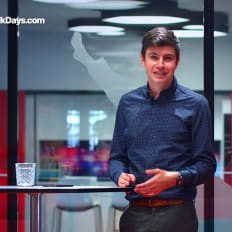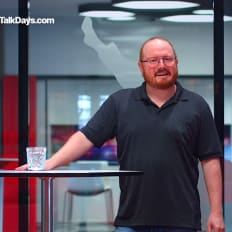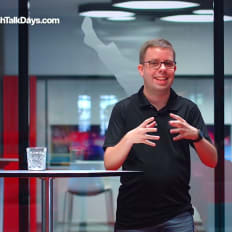
enjoy IT GmbH
Stefan Weinzettel, Bid Manager bei enjoy IT
Description
Stefan Weinzettel von enjoy IT berichtet im Interview über seinen Weg in das Bid Management, wie er in seiner Rolle im Unternehmen mit Developern zusammenarbeitet und gibt Tipps für Einsteiger.
By playing the video, you agree to data transfer to YouTube and acknowledge the privacy policy.
Video Summary
In "Stefan Weinzettel, Bid Manager bei enjoy IT", Stefan Weinzettel outlines his path from a finance-focused project controller working with contracts to a bid manager who leads the bid phase like a project—from cost modeling (internal/external resources, hosting, licenses) to delivering legally sound, on-time proposals in close collaboration with developers. He highlights tenders as stable multi-year business and the pivotal role of developers in shaping concepts, architecture, and timelines—takeaways for those who enjoy contracts and numbers and value cross-functional teamwork. He contrasts big-company rigidity with the privately run, almost family-like culture at enjoy IT GmbH, offering a real say, direct access to leadership, and benefits such as a day off on your birthday, two weeks off when you have a child, and regular team events.
From Finance to Bid Mastery: How Stefan Weinzettel at enjoy IT GmbH Wins Tenders and Shapes Culture
Insights from the session “Stefan Weinzettel, Bid Manager bei enjoy IT”
Listening to “Stefan Weinzettel, Bid Manager bei enjoy IT,” we at DevJobs.at heard a rare kind of story: a discipline often seen as dry—contracts, calculations, tenders—told as a living, deeply practical career narrative. Stefan walks us through 22 years of experience: from a post-“Hack” trainee program, across rotations through multiple departments, to landing in finance as a project buyer and controller—where contracts and cross-functional coordination became everyday work. A few years ago he deliberately leaned into bid management, especially in a software development context.
His core message: in a bid, you are effectively the project manager for the offer phase. You must meet deadlines, ensure legal soundness, calculate costs accurately, orchestrate internal expertise, and finally deliver a punctual, error-free, decision-ready proposal. In a mid-sized environment like enjoy IT GmbH, that responsibility comes with an extra dimension: room to shape processes, real attention from leadership, and a culture of appreciation.
“You’re practically the project manager in the bid phase of the bid project.”
This article organizes Stefan’s milestones, working principles, and cultural observations—and turns them into concrete takeaways for developers and tech leads who contribute to tenders or want to strengthen their influence during the offer phase.
22 years in: why contracts aren’t a necessary evil
Stefan’s entry into the field is clear: after the “Hack,” he joined a trainee program at his first employer. Rotating through departments gave him a broad view; he stayed in finance. As a project purchaser and controller, he worked closely with contracts and coordinated with project management, legal, and finance.
That experience produced a durable mindset: legal texts aren’t just compliance hurdles; they define the boundaries of a project—content, timing, economics. Reading, drafting, and negotiating them confidently—and translating them into numbers—brings clarity and reduces risk. For Stefan, legal and numerical work belong together:
Read contracts, write contracts—and “dress it up with numbers.”
A few years later, he expanded that skill set into bid management. In this role, his strengths merge: financial clarity, legal perspective, and the ability to connect technical teams to the logic of the offer.
Bid management in software development: ownership for the offer phase
Stefan frames the bid phase as its own project with clear ownership. The target is an offer that is “punctual, correct in content, legally secured.” In practice that means:
- Calculating internal personnel costs
- Planning external resources when needed
- Accounting for infrastructure factors (e.g., hosting)
- Pricing licenses appropriately
The domain is software development. So beyond implementation work, platform and licensing aspects must be captured cleanly. Importantly, regardless of project size, the steps are similar: assemble the bid team, gather expertise, calculate, review legally, and document. The variance lies in complexity—not in the fundamentals.
“No matter how big the project is … basically it’s relatively similar.”
That consistency is powerful. The better teams master the repeatable parts, the fewer surprises they face—especially when working to tight deadlines.
Developers as the primary knowledge carriers in the bid
In Stefan’s process, developers are the most critical stakeholders. They supply the content foundation: concept, specification, architecture document, timeline estimates, constraints. Without this backbone, every calculation is speculative. That makes developer alignment the central lever.
Developers define “how to implement, in what timeframe … and what we need to watch out for.”
For the bid role, that means: involve the right expertise early, prepare focused working sessions, make assumptions explicit, and structure documentation so the customer can make a decision. For developers, it means: emphasize clarity in architecture, scoping, and effort—and be able to capture that clarity in writing.
Where bids originate: platforms, inbound, and existing customers
According to Stefan, bids start from three directions:
- Public or private tender platforms
- Direct inquiries from customers
- Proactive suggestions to existing customers for further development
Each entry point brings a different level of information. The job is to quickly structure what’s known, surface what’s missing, and gather what’s required to produce “the documents the customer needs in order to make a decision.”
Tenders as steady volume—and the effort-to-volume equation
Stefan emphasizes tenders as a reliable volume driver because they often span multiple years. At the same time, he notes something that teams often underestimate: small offers carry relatively higher bid effort. The setup cost (assembling the team, calculating, aligning, documenting) occurs regardless of project size. Larger initiatives add complexity, but the process remains the same.
A 20,000-euro offer runs almost the same steps as a million-euro one—the calculation is “a bit more complex,” but the flow is similar.
Practically, this invites one strategy: standardize. Maintain templates and checklists, refine estimation models, and minimize the fixed effort per bid. With that foundation, teams can be more deliberate about which tenders to pursue.
After the win: from bid manager to project manager
Once the contract is awarded, ownership shifts: “I hand over directly to the project manager as soon as the project is won.” The bid phase ends and delivery begins. What carries over is the quality of the pre-work. The better the specification, architecture, assumptions, risks, and commercial parameters are documented, the smoother the handover.
For us, that underscores the dual value of good proposal documents: they don’t just convince the customer—they also accelerate project kickoff internally.
Mid-sized over mega-corporation: shaping work at enjoy IT GmbH
Stefan speaks from direct contrast. He previously worked in a global enterprise “with hundreds of thousands of employees,” defined by strict processes and the feeling of being “one of many.” At enjoy IT GmbH, he experiences the opposite: a privately run, mid-sized company with a young team, short lines to decision-makers, and the ability to help shape how bid management is done.
“People listen actively … you can get involved … I had the opportunity to help shape [bid management].”
Appreciation shows up in tangible ways, too: a day off on your birthday; two work weeks (ten days) off when you have a child—on top of vacation; quarterly team events that are more than a casual drink. Recent examples include one hour of go-karting in Linz and a wine tasting in the Wachau. And the Christmas party? Already planned in February—a detail that reads like a wink but signals real attention to team life.
“Appreciation is very big in the company.”
The thread is simple: when people feel heard and valued, they lean into responsibility.
Seven practices developers can adopt for stronger bids
Stefan’s perspective translates into concrete working habits for developers and tech leads involved in tenders:
- Nail architecture and scope early
- A concise, defensible architecture and specification is the only basis for meaningful cost and timeline estimates.
- Bridge legal and technical realities
- “Legally secured” isn’t optional. Align on license models, hosting arrangements, and dependencies—with legal and finance in the loop.
- Treat deadlines as quality criteria
- Tenders are deadline-driven. Punctual internal contributions are part of the quality promise to the customer.
- Standardize the small bids
- Because setup effort is largely fixed, templates and checklists pay off most for smaller opportunities.
- Center developer input
- Bid decisions hinge on technical truth. Continuous, direct involvement of the engineering team is non-negotiable.
- Optimize for completeness and consistency
- The customer needs to decide. Ensure the proposal is accurate, consistent, and traceable—no gaps, no contradictions.
- Write for the handover
- Capture assumptions, risks, interfaces, and boundaries in the offer. That documentation becomes the delivery starting point.
A grounded bid checklist that actually maps to reality
From Stefan’s account, a pragmatic checklist emerges:
- Assess requirements: what’s clear, what’s missing?
- Assemble the bid team: project manager (for later handover), developers (knowledge), finance, and legal as needed.
- Create the technical backbone: concept, specification, architecture document, effort estimates, risks.
- Run the calculation: internal/external resources, hosting, licensing.
- Perform legal review: wording, liability, licensing, data protection—ensure “legally secured.”
- Consolidate documents: error-free, complete, decision-ready—with consistent terminology.
- Manage deadlines: punctual submission; earlier internal deadlines with buffers.
- Prepare the handover: a structured package for the project manager in case of award.
The value isn’t in novelty; it’s in repeatability. Stefan’s description makes clear that the ability to run this process consistently is what separates professional bids from ad-hoc scrambling.
Why “dry” legal texts are useful—even in private life
One of Stefan’s understated points: learning to read legal language pays off beyond work. It’s about comprehension—understanding “what is meant when it’s not written in simple German.” That skill reduces misunderstandings, strengthens negotiation footing, and brings precision to project delivery.
Culture that enables ownership: availability, trust, responsibility
Stefan’s examples of appreciation are concrete: management that’s available “even on weekends” when something is urgent; events with substance; planned space for life events (birthday, the birth of a child); and, above all, being “actively listened to.” Within bid management there’s a defined framework, yet he “had the opportunity” to shape how things are done.
For tech talent, that culture means you’re measured not just on outputs but also engaged in how those outputs are created. If you want to take ownership, structures exist to make that possible—and benefits acknowledge real life.
Contrast as clarity: enterprise processes vs. mid-sized momentum
The comparison is stark. In a company “with hundreds of thousands of employees,” strict processes are necessary—and the sense of anonymity can be real. In a mid-sized firm, Stefan experiences familiar faces, informal after-work time, short feedback loops, and the feeling of being seen. For bid work, that can translate into faster alignment, fewer handover losses, greater ownership, and the chance to shape workflows.
Career cues from Stefan’s path
Without prescribing, Stefan’s journey suggests useful signals:
- Embrace rotations: broad exposure (as in trainee programs) helps you find a meaningful niche.
- Build interface skills: finance, legal, project, and engineering—translating across them makes you indispensable.
- Treat offers as projects: ownership in the offer phase pays off twice—with the customer and with delivery.
- Evaluate culture: appreciation and the chance to shape work aren’t perks; they’re productivity drivers.
- Standardize relentlessly: repeatable processes reduce bid costs and increase reliability.
Conclusion: bid management as team sport—and a cultural product
“Stefan Weinzettel, Bid Manager bei enjoy IT” shows how powerful bid work becomes when teams embrace it fully. It demands precision, time discipline, legal awareness, and technical substance. And it depends on someone to weave those threads together into a punctual, error-free, decision-ready whole. In enjoy IT GmbH, that work sits on a cultural foundation of attentiveness, tangible benefits, and real room to shape how things are done.
Our central takeaway: good bids aren’t luck. They’re the output of a repeatable process where developers supply technical truth, finance and legal ensure guardrails, and a bid owner carries responsibility to the finish line. That’s the role Stefan describes—and it’s what turns opportunity into award.
To situate the perspective: these insights come from the session “Stefan Weinzettel, Bid Manager bei enjoy IT” (Speaker: Stefan Weinzettel, Company: enjoy IT GmbH). What lingers is practical and grounded: care, clarity, punctuality, teamwork—and a culture that makes them possible.
More Dev Stories

enjoy IT GmbH Julian Deleja-Hotko, Software Developer bei enjoy IT
Julian Deleja-Hotko von enjoy IT redet im Interview über seine Anfänge mit dem Programmieren, was er in seiner aktuellen Arbeit macht und was seiner Meinung nach für Neueinsteiger wichtig ist.
Watch now
enjoy IT GmbH Thomas Hochgatterer, Back End Developer bei enjoy IT
Thomas Hochgatterer von enjoy IT gibt im Interview Einblicke in seinen Werdegang mit dem Prorammieren, wie sich sein Arbeitsalltag als Back End Developer gestaltet und gibt Tipps für Neueinsteiger.
Watch now
enjoy IT GmbH Joachim Waldl, Front End Developer bei enjoy IT
Joachim Waldl von enjoy IT gibt im Interview einen Einblick in seinen Werdegang zum Programmieren, einen Überblick in seine aktuelle Arbeit im Front End Development und schließlich Tipps für Beginner.
Watch now
enjoy IT GmbH Christof Amtmann, Project Manager bei enjoy IT
Christof Amtmann von enjoy IT spricht im Interview darüber, wie er über Umwege zum Project Management gekommen ist, was seine aktuelle Arbeit umfasst und gibt Tipps für Neueinsteiger.
Watch now
enjoy IT GmbH Oktay Akgül, Lead Developer bei enjoy IT
Oktay Akgül von enjoy IT erzählt im Interview wie er zum Programmieren gekommen ist, wie sich dann der Weg bis zu aktuellen Arbeit als Lead Developer gestaltet hat und gibt Tipps für Neueinsteiger.
Watch now
enjoy IT GmbH Thomas Hintersteiner, Software Architect bei enjoy IT
Thomas Hintersteiner von enjoy IT erzählt im Interview über seinen Weg – angefangen von der HTL bis hin zu seiner aktuellen Arbeit – und gibt Tipps für Personen die selbst mit dem Programmieren anfangen möchten.
Watch now






